spring源码分析——BeanDefinitionRegistryPostProcessor接口与BeanFactoryPostProcessor接口
一:BeanDefinitionRegistryPostProcessor 与BeanFactoryPostProcessor接口
这个接口支持自定义beanDefinition的注册,在标准的注册完成后(解析xml或者注解),在与实例化对象之前,实现这个接口
可以向beanDefinitionMap中注册自定义的beanDefinition,这个接口从定义上看更多的是关注注册。
1:实现beanDefinitionRegistryPostProcessor接口,重写postProcessBeanDefinitionRegistry方法,在方法内创建beanDefinition对象,然后注册到beanDefinitionRegistry中
创建一个pojo对象BeanDemo,用于测试在接口中注册自定义beanDefinition
public class BeanDemo {
private String name = "hello";
public String getName() {
return name;
}
public void setName(String name) {
this.name = name;
}
@Override
public String toString() {
final StringBuffer sb = new StringBuffer("BeanDemo{");
sb.append("name='").append(name).append('\'');
sb.append('}');
return sb.toString();
}
}
@Component
public class MyBeanDefinitionRegistryPostProcessor implements BeanDefinitionRegistryPostProcessor {
public void postProcessBeanDefinitionRegistry(BeanDefinitionRegistry registry) throws BeansException {
System.out.println("MyBeanDefinitionRegistryPostProcessor: "+registry);
// 向beanDefinitionMap中注册自定义的beanDefinition对象
GenericBeanDefinition beanDefinition = new GenericBeanDefinition();
beanDefinition.setBeanClass(BeanDemo.class);
registry.registerBeanDefinition("beanDemo",beanDefinition);
}
public void postProcessBeanFactory(ConfigurableListableBeanFactory beanFactory) throws BeansException {
System.out.println("MyBeanDefinitionRegistryPostProcessor: "+beanFactory);
}
}

成功的从spring容器中拿到了对象:

2:BeanFactoryPostProcessor接口
这个接口支持修改容器内的beanDefinition对象,也可以直接注册bean对象,在标准的beanDefinition注册之后以及预实例化bean对象之前

通过运行结果可以看出beanDefinition在postProcessBeanFactory方法中被修改:

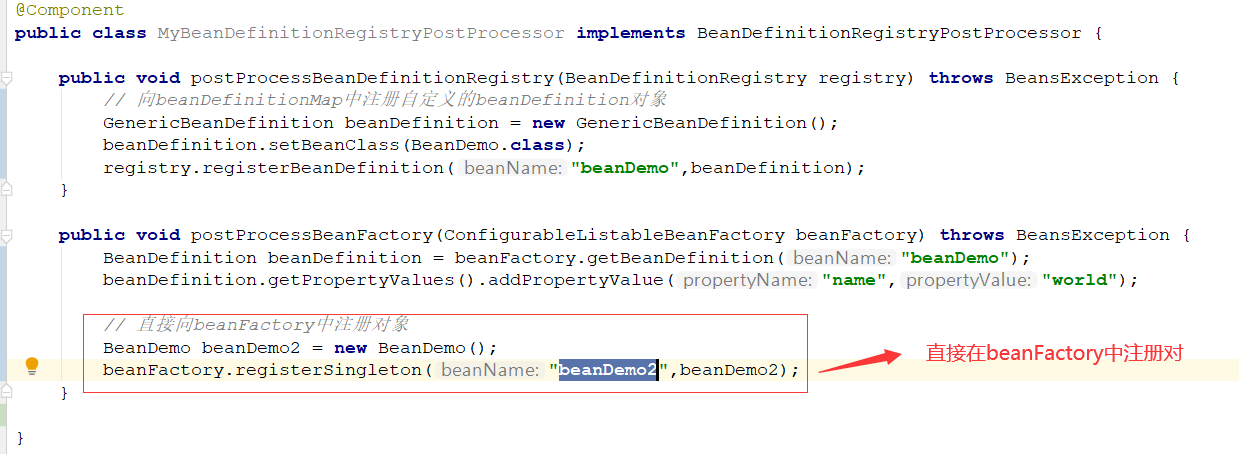


在beanFactoryPostProcessor接口中注册对象后,可以在spring中获取到。
二:从源码层面分析接口调用
refresh方法中invokeBeanFactoryPostProcessors:
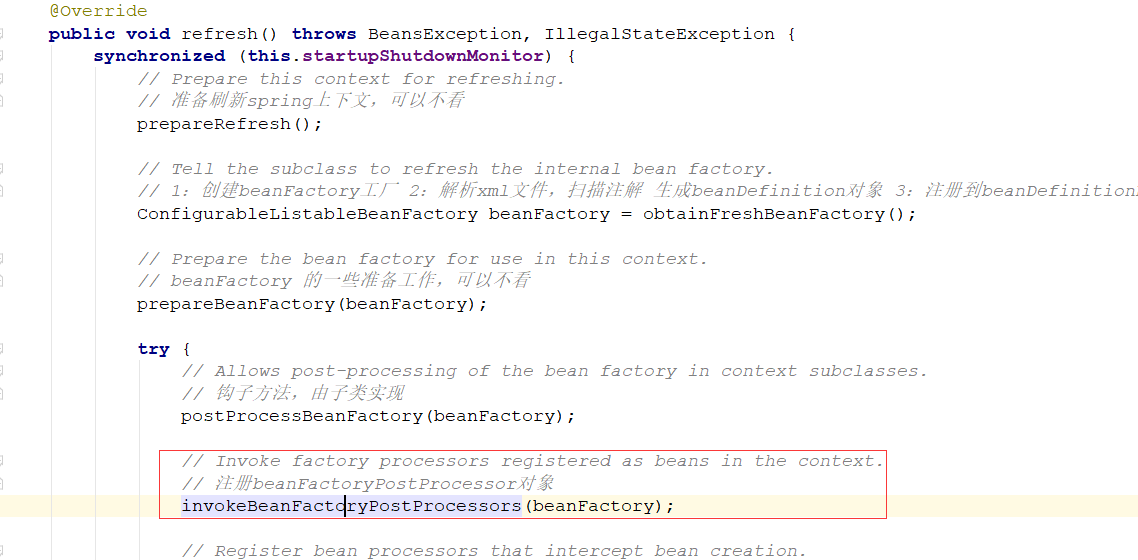

主要的核心逻辑都在这个方法内:

public static void invokeBeanFactoryPostProcessors(
ConfigurableListableBeanFactory beanFactory, List<BeanFactoryPostProcessor> beanFactoryPostProcessors) {
// Invoke BeanDefinitionRegistryPostProcessors first, if any.
// 如果存在BeanDefinitionRegistryPostProcessor类型对象,要先调用
Set<String> processedBeans = new HashSet<>();
if (beanFactory instanceof BeanDefinitionRegistry) {
BeanDefinitionRegistry registry = (BeanDefinitionRegistry) beanFactory;
List<BeanFactoryPostProcessor> regularPostProcessors = new ArrayList<>();
List<BeanDefinitionRegistryPostProcessor> registryProcessors = new ArrayList<>();
// 第一次进来beanFactoryPostProcessors集合为空,不会走进来
for (BeanFactoryPostProcessor postProcessor : beanFactoryPostProcessors) {
if (postProcessor instanceof BeanDefinitionRegistryPostProcessor) {
BeanDefinitionRegistryPostProcessor registryProcessor =
(BeanDefinitionRegistryPostProcessor) postProcessor;
registryProcessor.postProcessBeanDefinitionRegistry(registry);
registryProcessors.add(registryProcessor);
}
else {
regularPostProcessors.add(postProcessor);
}
}
// Do not initialize FactoryBeans here: We need to leave all regular beans
// uninitialized to let the bean factory post-processors apply to them!
// Separate between BeanDefinitionRegistryPostProcessors that implement
// PriorityOrdered, Ordered, and the rest.
/**
* 不要在这里初始化FactoryBean类型的对象,不要初始化post-Processor对象,要把
* PriorityOrdered类型和Ordered类型以及剩下的分开
*/
List<BeanDefinitionRegistryPostProcessor> currentRegistryProcessors = new ArrayList<>();
// First, invoke the BeanDefinitionRegistryPostProcessors that implement PriorityOrdered.
/**
* 1: 根据类型找到所有实现BeanDefinitionRegistryPostProcessor接口的beanName
* 2: 遍历所有beanName,判断是否是PriorityOrdered接口的实例
* 3: 如果是则 getBean实例化这个对象,然后放入processedBean集合中
*
* 在这里getBeanNamesForType 会把字父类的beanDefinition合并Merge,得到RootBeanDefinition
*/
String[] postProcessorNames =
beanFactory.getBeanNamesForType(BeanDefinitionRegistryPostProcessor.class, true, false);
for (String ppName : postProcessorNames) {
if (beanFactory.isTypeMatch(ppName, PriorityOrdered.class)) {
currentRegistryProcessors.add(beanFactory.getBean(ppName, BeanDefinitionRegistryPostProcessor.class));
processedBeans.add(ppName);
}
}
/**
* 1:对currentRegistryProcessors集合内实例对象排序
* 2: 将排序过的集合添加到注册集合registryProcessors中
* 3:调用currentRegistryProcessors集合中对象方法
* 4:清空当前注册对象集合currentRegistryProcessors
*/
sortPostProcessors(currentRegistryProcessors, beanFactory);
registryProcessors.addAll(currentRegistryProcessors);
// 调用注册对象方法
invokeBeanDefinitionRegistryPostProcessors(currentRegistryProcessors, registry);
currentRegistryProcessors.clear();
// Next, invoke the BeanDefinitionRegistryPostProcessors that implement Ordered.
/**
* 在这里步骤和上一步类似,只不过这里操作的是实现Ordered接口的类
*/
postProcessorNames = beanFactory.getBeanNamesForType(BeanDefinitionRegistryPostProcessor.class, true, false);
for (String ppName : postProcessorNames) {
if (!processedBeans.contains(ppName) && beanFactory.isTypeMatch(ppName, Ordered.class)) {
currentRegistryProcessors.add(beanFactory.getBean(ppName, BeanDefinitionRegistryPostProcessor.class));
processedBeans.add(ppName);
}
}
sortPostProcessors(currentRegistryProcessors, beanFactory);
registryProcessors.addAll(currentRegistryProcessors);
invokeBeanDefinitionRegistryPostProcessors(currentRegistryProcessors, registry);
currentRegistryProcessors.clear();
// Finally, invoke all other BeanDefinitionRegistryPostProcessors until no further ones appear.
/**
* 还是重复上面的动作,不过这次是排除掉上面已经调用过的实例(实现PriorityOrdered和Ordered接口)
*/
boolean reiterate = true;
while (reiterate) {
reiterate = false;
postProcessorNames = beanFactory.getBeanNamesForType(BeanDefinitionRegistryPostProcessor.class, true, false);
for (String ppName : postProcessorNames) {
if (!processedBeans.contains(ppName)) {
currentRegistryProcessors.add(beanFactory.getBean(ppName, BeanDefinitionRegistryPostProcessor.class));
processedBeans.add(ppName);
reiterate = true;
}
}
sortPostProcessors(currentRegistryProcessors, beanFactory);
registryProcessors.addAll(currentRegistryProcessors);
invokeBeanDefinitionRegistryPostProcessors(currentRegistryProcessors, registry);
currentRegistryProcessors.clear();
}
// Now, invoke the postProcessBeanFactory callback of all processors handled so far.
/**
* 在这里,调用上面已经处理过的所有处理器的postProcessBeanFactory回调方法
*/
invokeBeanFactoryPostProcessors(registryProcessors, beanFactory);
invokeBeanFactoryPostProcessors(regularPostProcessors, beanFactory);
}
else {
// Invoke factory processors registered with the context instance.
invokeBeanFactoryPostProcessors(beanFactoryPostProcessors, beanFactory);
}
// Do not initialize FactoryBeans here: We need to leave all regular beans
// uninitialized to let the bean factory post-processors apply to them!
String[] postProcessorNames =
beanFactory.getBeanNamesForType(BeanFactoryPostProcessor.class, true, false);
// Separate between BeanFactoryPostProcessors that implement PriorityOrdered,
// Ordered, and the rest.
List<BeanFactoryPostProcessor> priorityOrderedPostProcessors = new ArrayList<>();
List<String> orderedPostProcessorNames = new ArrayList<>();
List<String> nonOrderedPostProcessorNames = new ArrayList<>();
for (String ppName : postProcessorNames) {
if (processedBeans.contains(ppName)) {
// skip - already processed in first phase above
}
else if (beanFactory.isTypeMatch(ppName, PriorityOrdered.class)) {
priorityOrderedPostProcessors.add(beanFactory.getBean(ppName, BeanFactoryPostProcessor.class));
}
else if (beanFactory.isTypeMatch(ppName, Ordered.class)) {
orderedPostProcessorNames.add(ppName);
}
else {
nonOrderedPostProcessorNames.add(ppName);
}
}
// First, invoke the BeanFactoryPostProcessors that implement PriorityOrdered.
sortPostProcessors(priorityOrderedPostProcessors, beanFactory);
invokeBeanFactoryPostProcessors(priorityOrderedPostProcessors, beanFactory);
// Next, invoke the BeanFactoryPostProcessors that implement Ordered.
List<BeanFactoryPostProcessor> orderedPostProcessors = new ArrayList<>();
for (String postProcessorName : orderedPostProcessorNames) {
orderedPostProcessors.add(beanFactory.getBean(postProcessorName, BeanFactoryPostProcessor.class));
}
sortPostProcessors(orderedPostProcessors, beanFactory);
invokeBeanFactoryPostProcessors(orderedPostProcessors, beanFactory);
// Finally, invoke all other BeanFactoryPostProcessors.
List<BeanFactoryPostProcessor> nonOrderedPostProcessors = new ArrayList<>();
for (String postProcessorName : nonOrderedPostProcessorNames) {
nonOrderedPostProcessors.add(beanFactory.getBean(postProcessorName, BeanFactoryPostProcessor.class));
}
invokeBeanFactoryPostProcessors(nonOrderedPostProcessors, beanFactory);
// Clear cached merged bean definitions since the post-processors might have
// modified the original metadata, e.g. replacing placeholders in values...
beanFactory.clearMetadataCache();
}
实例化并调用实现PriorityOrdered接口的BeanDefinitionRegistryPostProcessor实现对象:
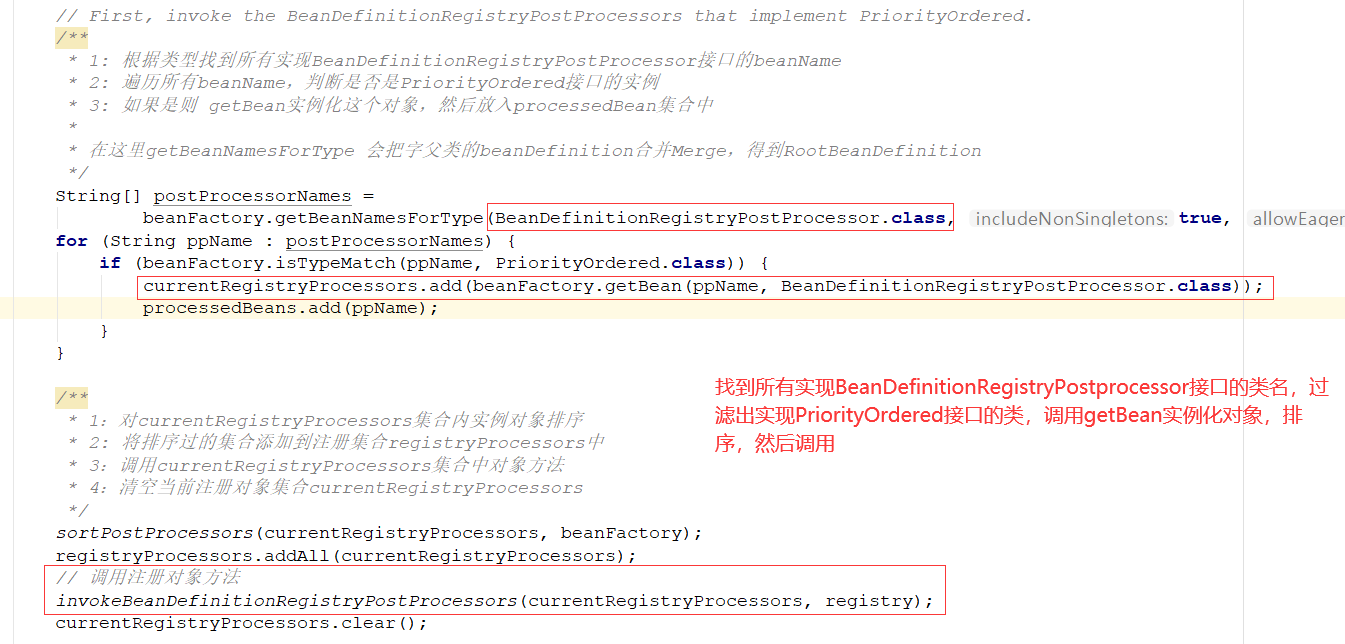
调用接口:

实例化并调用实现Ordered接口的BeanDefinitionRegistryPostProcessor实现对象:
操作和刚才类似,只不过这次是调用实现Ordered接口的实现对象

实例化其他的BeanDefinitionRegistryPostProcessor实现对象:

因为BeanDefinitionRegistryPostProcessor接口继承了 BeanFactoryPostProcessor接口,所以也是BeanFactoryPostProcessor的子类

把刚才已经调用过BeanDefinitionRegistryPostProcessor接口的对象,在调用BeanFactoryPostProcessor接口


到这里 实现BeanDefinitionRegistryPostProcessor接口的对象都调用了 BeanFactoryPostProcessor 的实现类,但是还有单独只实现了 BeanFactoryPostProcessor 接口的,
而没有实现 BeanDefinitionRegistryPostProcessor 的,也需要调用 postProcessorBeanFactory方法:
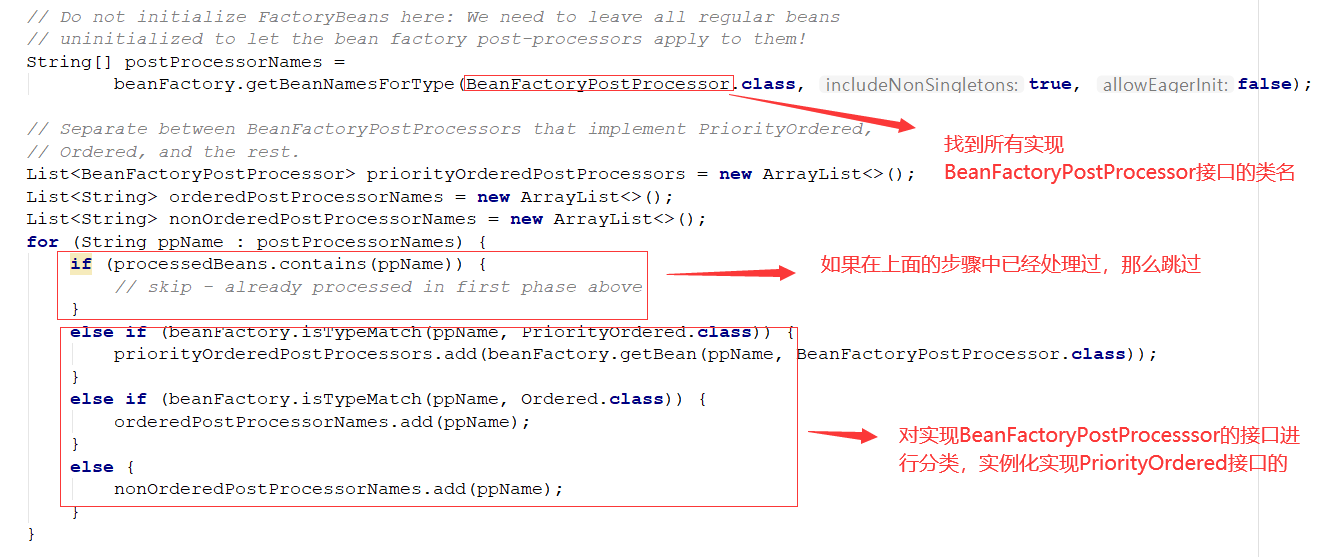
实例化并调用对象:
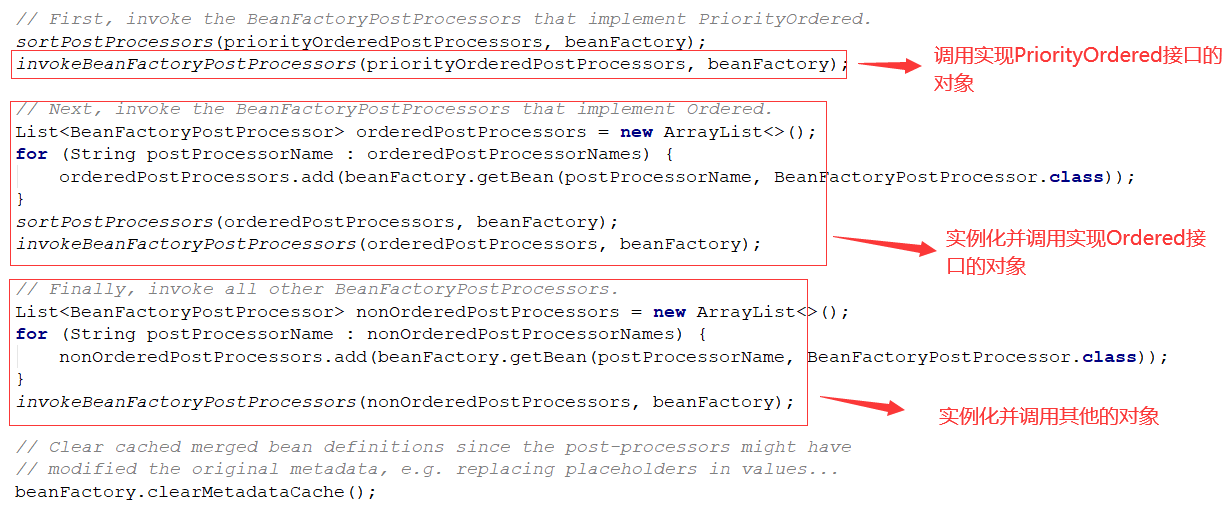
到这里所有实现BeanFactoryPostProcessor接口的类都实例化并调用过了。
总结:这两个接口是在标准的加载解析,生成BeanDefinition对象完成注册后,非懒加载的对象预实例化之前 ,预留的后置接口,支持自定义BeanDefinition
然后实现注册,BeanDefinitionRegistryPostProcessor侧重于注册信息,BeanFactoryPostProcessor侧重于修改BeanDefinition对象的信息,也可以直接注册bean对象。



